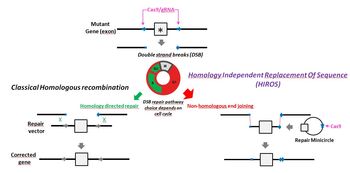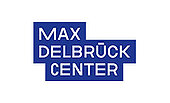Homology Independent Genomic Sequence Replacement
Challenge
Advances in genome sequencing and targeted editing technologies have enhanced the feasibility of genome engineering approaches, especially with respect to potential future therapeutic applications. Nevertheless, there are still major limitations in terms of editing efficiencies and broad access to relevant and desired cell types. Current cell manipulation and therapy approaches that aim for a site-specific exchange of DNA sections are based on classical homologous recombination strategies for precise and controlled sequence replacement. As homology directed repair (HDR) is not readily accessible to non-dividing cells, which are composing most of the adult tissue, this creates a barrier for the development of novel treatments for a wide range of genetic disorders as well as for the understanding of fundamental biological principles. Thus, new editing technologies are required that can overcome existing constraints.
Technology
The novel genetic replacement strategy HIROS (Homology Independent Replacement of Sequences) is based on CRISPR/Cas9 genome modifications by selecting suitable sgRNAs that excise a desired genomic fragment by creating two double strand breaks in the presence of a donor plasmid. The donor plasmid carries the substitute fragment and is designed to be cut in parallel releasing such fragment. Flanked by the double stranded breaks the presence of the substitute fragment leads to a high rate of sequence replacement (about 30%) through integration into the gap created by excision of the undesired genomic DNA segment.It has been shown that this replacement strategy is achieved by the non-homologous end joining (NHEJ) pathway of DNA repair. Consequently, the novel DNA replacement strategy is not dependent on homology sequences. Nevertheless, it can still be applied in a targeted manner promoting directed sequence replacement in the correct orientation. In contrast to the general belief that NHEJ is an error-prone process it has been demonstrated that in presence of a substitute fragment this replacement is mainly error-free. Thus, this new methodology opens up a whole new field of genomic manipulation and repair strategies, as NHEJ is not associated with particular phases of the cell cycle. In particular, non-dividing cells can be efficiently and easily addressed for the first time creating the potential for new avenues for basic research as well as for therapeutic and cell therapy approaches in the future.
Commercial Opportunity
The technology is offered for in-licensing or collaborative development.
Development Status
Proof of concept has been demonstrated by using fluorescent reporter systems in genetically modified HeLa and HEK293 cells. Replacement efficiencies of up to 30% have been demonstrated resulting in up to 90% of correct replacement events. Current work is addressing the modification of primary cells from lung as well as first AAV-based gene therapy approaches in mice.
Patent Situation
A European priority application has been filed in 2018 followed by a PCT application (WO2019/122302A1). National phases were entered in US and EP.
Further Reading
Danner et al., 2020, bioRxiv preprint: "A Homology Independent Sequence Replacement Strategy in Human Cells Using a CRISPR Nuclease".





